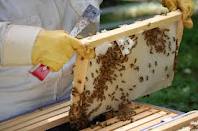Week 3 - Properties of Gases and Liquids Explained by the Particle Model
2. Changing Viscosity
Changing Viscosity
Textbook Readings
ScienceFocus 8
Pages 45, 46, 48, 49
or
Science in Action 8
Pages 39, 41
Viscosity is important in many other industries as well and the ability to change the viscosity of a fluid is very important.
View the following multimeda presentation on viscosity in beekeeping.
After reading the section below ask yourself the following question.
What two things effect the rate of flow of honey?

Viscosity and Honey
The viscosity or sticky nature of honey causes it to resist movement through the extractor, pump, pipes, and strainers.
Viscosity describes the rate of flow of a liquid. A thick, slow, flowing liquid has a high viscosity (good body) and a thin liquid has low viscosity.
Liquid honey with a high moisture content has a low viscosity. Honey with a low moisture content has high viscosity. Cold honey has a high viscosity, warm honey a low viscosity. Therefore, a low moisture, cold honey is hard to handle.
The viscosity of honey can be lowered temporarily by applying heat, but as the honey cools viscosity increases again. Heating honey lowers viscosity (increases rate of flow), making easier the jobs of extracting, pumping, straining, and settling. Warm weather also helps lower viscosity. Therefore, the more honey extracted when weather is warm, the better.
Heating honey, unfortunately, releases the aromatic volatile oils, destroys enzymes and darkens the honey. The problem is one of moving the honey as quickly as possible with the least possible damage to its quality.
Viscosity and Temperature
"As slow as Molasses in January." Why is molasses in January so slow? Why is it slower in January then June or July? Because viscosity is dependent on temperature .
There are several different methods of measuring the rate of flow.
| Concept Review You may drop an object into a liquid as in the previous activity or You may pour the liquid through a narrow opening like a funnel and measure the time it takes to flow through. |
One option is to heat it up . Many restaurant serve syrup warm so it will be easier to pour.
Another method is to mix it with another substance. Water has a relatively low viscosity (meaning it is not thick), therefore as long as the substance will mix with water , adding water can lower the viscosity.
Mixing fluids to change viscosity Since water has a relatively low viscosity then mixing it with something that has a relatively high viscosity should reduce the overall viscosity.
This is true as long as the two substances mix. For example water could be mixed with molasses to thin it but it could not be used to reduce the viscosity of oil because oil and water do not mix.
Exercise 3.2: Flow Rate Lab

|
|
Enrichment:
Optional Research / Discussion topic: In which other industries is viscosity important. |
|
© 2002 Alberta Online Consortium
|
